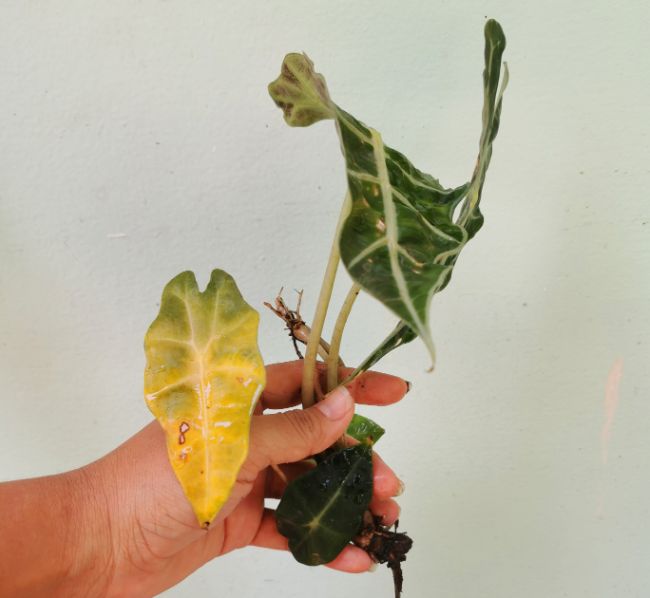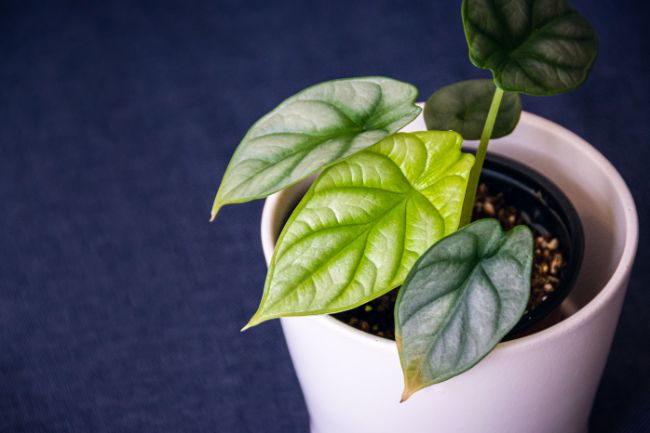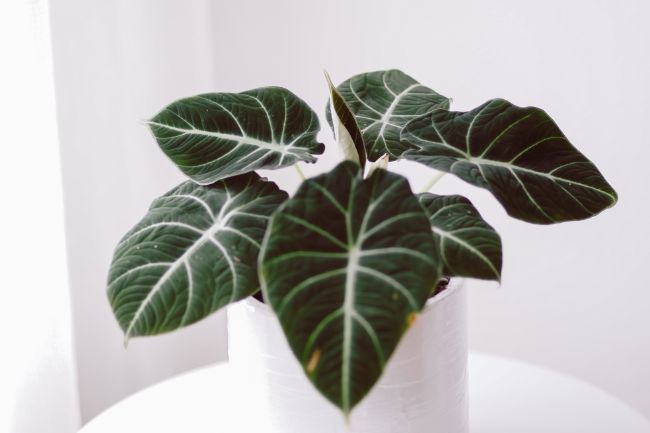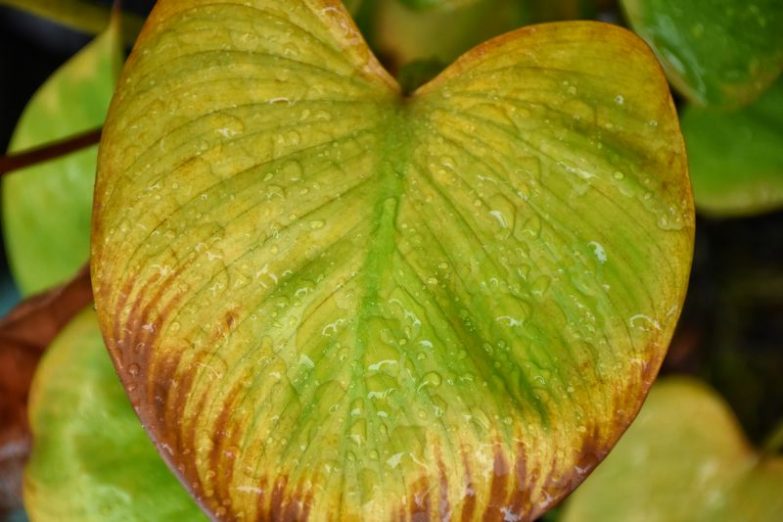Alocasias are magnificent plants, but they can be temperamental. It’s not uncommon for their leaves to turn yellow despite our best efforts. This article is going to explain why your Alocasia leaves are turning yellow and help you to fix your plant.
The most common cause of Alocasia leaves turning yellow is overwatering. A heavy, holding soil can contribute to the problem. Insufficient light, low humidity, and lack of warmth, nutritional deficiencies, pest infestation, or disease are other possibilities.
Overview: Why Do Alocasias Get Yellow Leaves?
Alocasias originate from the tropical forests of Asia and Eastern Australia. They have stiff, upright stems (petioles) and magnificent leaves – leaves that are prone to turning yellow from stress. Since the plant can be finicky to keep in a temperate zone, yellow leaves are a common problem.
An Alocasia generally likes bright, hot conditions. Some varieties want more light or water than other species. It’s important to research your specific plant type.
To diagnose the likely cause of yellow leaves accurately and fix the issue, the first step is to rule out overwatering. If this isn’t the culprit, look at the other possibilities until you find the problem.
What Kind of Alocasia Do You Have?
A subgroup known as Jewel Alocasias is popular for their small size and beautiful foliage, but they have different needs than most other Alocasia species.
Jewel Alocasias like a very fast-draining mix that stays a bit drier than is recommended for other Alocasias. They prefer to be slightly underpotted and are more insistent about higher temperatures.
11 Causes Of Alocasia Leaves Turning Yellow (And Solutions)
Normal Aging
When you search for the cause of your Alocasia’s yellow leaves, don’t overlook simple aging. Their leaves grow old and turn yellow as they die. It’s the natural process.
Even if your Alocasia is getting the right light and you’re watering correctly, occasional yellow leaves are inevitable. It is a stage in their foliage’s life cycle: old leaves are shut down and drained of resources, which turns them yellow. This often happens just as a new leaf is emerging.
Age-based shutdown mainly happens to older, outer leaves. If your plant has proper light and water, occasional yellow leaves are no reason to worry. As long as your Alocasia is putting out new, healthy foliage, you’re on the right track.
Overwatering Is The Most Common Cause Of Alocasia Leaves Turning Yellow
Yellow leaves are the classic symptom of overwatering. Immediately check the soil and review your recent watering regimen. Alocasias prefer moist soil but can easily be overwatered.
If you think the plant is overwatered, check the roots for rot. Gently unpot the plant and inspect the roots: they should be firm, white, and earthy-smelling. Rotted roots are foul-smelling, squishy and brown. Cut away any infected parts and repot with fast-draining, dry soil.
Remember that some Alocasias like to be drier between waterings, while others like evenly moist soil. Monitor the plant, and water to its specifications.
Note: Make sure your plant’s container has adequate drainage holes. Pebbles at the bottom of a closed pot won’t do the job.

Water Quality
Alocasias are sensitive to heavily mineralized or contaminated water, and they show their unhappiness in their leaves. The main symptoms of a plant reacting poorly to its water source leaf spotting and brown tips, but the leaves can yellow too.
If you use tap water, make sure it has been chemically neutralized with a few drops of de-chlorinator. If the leaves continue to become discolored, consider switching to purified water or rainwater. If you’d like to learn more, read my article about the pros and cons of different water types for houseplants.
Soil
Your Alocasia’s soil plays an inconspicuous but critical role in watering. A light, open mix that retains some water makes it possible to keep your Alocasia properly hydrated and safe from dreaded root rot and general malaise.
Tips to keep in mind:
- Jewel Alocasias do best in soil that resembles orchid mix. Their ideal soil features a quantity of amendments like bark and perlite for a super fast-draining medium.
- Typical Alocasias like a soil made with potting mix with aerating amendments added to give the medium a lofty, open structure.
- Peat is a good addition to the mix if you want to increase the soil’s capacity to hold water. However, depending upon your specific Alocasia, peat might hold too much moisture if it’s a big percentage of the medium.
Are Your Alocasia Leaves Turning Yellow Due To Lighting Problems?
Lighting issues are fairly common causes of Alocasia leaves turning yellow. Alocasias are sometimes described as low-light plants since they naturally grow in tropical shade, but forest shade is quite bright compared to most indoor conditions.
Indoors, Alocasias generally like to be close to a bright window while protected from intense direct sun.
Seasonal changes can sneak up. A plant thriving near a sunny window may slowly start to struggle as autumn light fades. If you’re seeing pale or lackluster growth and the plant is in moderate light, consider moving it to a brighter location or adding a grow light.
The light can also be too bright. Yellowing or browning foliage and scorched or bleached leaves are signs of overexposure. I’ve written an article that goes into more detail on lighting for houseplants, to help you get your plants in the perfect spot.
Temperature Problems Causing Yellow Leaves On Alocasias
Leaf yellowing and decline are possible symptoms your plant wants a warmer spot. Alocasias are warmth-loving plants that do well in a range between 65ºF (18ºC) and 85ºF (29ºC). The plant isn’t frost tolerant and suffers as temperatures fall below 55ºF (13ºC).
If you keep indoor temperatures cool, your Alocasia might not be getting the heat it thrives upon. A strict preference for the warm end of the scale is why some varieties are hard to manage indoors.
It’s also important to keep the temperature from fluctuating too rapidly or widely. Some growers use a heating pad to keep their plant’s roots warmer than room temperature.

Humidity
Alocasias love humidity. They may adapt to lower levels, but will grow best at levels above 60% or even 70%.
Yellow, lackluster leaves with brown edges or tips are symptoms of low humidity. Discoloration happens gradually on leaves all over the plant. A safe humidity minimum is about 50%, though some growers report success with even lower levels.
If you have at least average humidity, you can elevate it slightly by grouping your Alocasia with other plants, preferably tropicals, and placing water-filled trays close by. If your Alocasia is coping with less than ideal humidity, you can support it by vigilant, careful watering.
Unless you live in a tropical area, a humidifier is the answer to raising your humidity to ideal levels. You can read more about how to increase humidity levels for your houseplants in this article.
Lack Of Fertilizer Can Cause Yellow Leaves On Alocasias
Though it’s not the most common cause, a lack of nutrition can result in Alocasia leaves turning yellow. Alocasias grow briskly during the warm growing season and benefit from regular feeding every two to four weeks. If they run low on nutrients, they can accelerate retirement of older leaves to salvage the resources.
If you suspect lack of nutrition, don’t rush to feed the plant more. Proceed gradually to avoid shock: if you haven’t been fertilizing, establish a regular feeding plan; if you already fertilize, stick to the schedule but increase the amount slightly.
Watch the foliage carefully in the weeks after application. If you don’t note a positive change, return to the plant’s original feeding regimen and check other factors.
If you see an improvement in the plant’s color and/or vigor, continue feeding the corrected dose to see if the problem resolves … don’t keep increasing if there’s no improvement. With fertilization, more can be less!
Tips:
- The best way to fertilize is with a liquid solution that permeates the soil and root ball. Add water to a dry dose and apply as a liquid.
- If you’re using a synthetic formula, dilute to one-half the label recommendation.
- Organic fertilizers are less prone to “burning” sensitive roots and don’t need dilution.
- Retailers, local nurseries, or your agricultural office sell soil test kits for a definitive reading.
- Read more about fertilizing houseplants in this article.
Overfertilization
It’s easy to over-feed an Alocasia. The symptoms are burned leaf tips and edges. Leaves can yellow and die if their roots are burned from fertilizer or toxified soil.
Make changes in your established feeding regimen slowly and watch how the plant reacts. Feed only in spring and summer; stop fertilization in the cooler months.
Overfertilization can toxify the soil with residual salts. It’s a good practice to flush the mix at watering time or at least every month or two. Wet the soil thoroughly and let excess water wash out the drain holes.

Pests Can Result In Alocasia Leaves Turning Yellow
Alocasias are subject to common houseplant pests like aphids, thrips, scale and spider mites. Those big, soft, juicy leaves are a big attraction, so check your plant often.
A plant with an infestation can get yellowed and/or mottled leaves as the life is sucked out of them. Tiny white spots on the leaves are signs of pests; spider mites leave little webs and congregate near the leaf’s main veins.
If you only see a few bugs, you can spot eliminate them with a dab of isopropyl (rubbing) alcohol … but if it’s become an infestation, your plant will need treatment.
Insecticidal soap is gentle and generally effective. Here’s how to apply:
- Isolate the plant to avoid further contamination.
- Wash off as many pests as possible. Do this outside or in a bathroom, and protect the soil from being overly soaked.
- Thoroughly wipe down all the leaves and stems with soapy insecticidal solution or just a mix of water and liquid dish soap. The solution must contact the pests to kill them.
- Check the plant and repeat the treatment every four to six days until the infestation has been eradicated. It’s likely to take several repetitions. Read my guide to identifying, treating, and preventing houseplant pests in this article.
Note: A pest issue often indicates that the plant is under stress from another factor. Review the plant’s care and make necessary changes.
Acclimatization And Dormancy
Sometimes an Alocasia needs time to acclimate to new surroundings, whether it’s a new purchase or just coming in from a summer season. A dramatic change in lighting can trigger dormancy, too. The leaves may turn yellow and die as the plant adjusts.
Stop Moving Them. Moving a plant around to find the best spot is a common response to yellow leaves, but this might make the problem worse. Make sure a new location is a beneficial change.
Note: If the plant is dormant, keep it a bit drier – it’s very easy to overwater a sleeping Alocasia. A dormant Alocasia will normally produce new growth after a few months.
Should You Cut Off Yellow Alocasia Leaves?
It’s often best to wait before cutting yellow leaves off an Alocasia until the leaves have turned completely yellow and died. Even a leaf that is partially yellow can still be providing energy for the plant and removing it too early can do more harm than good.
The exception to this is when yellow Alocasia leaves are caused by a disease. In this instance, it is crucial to remove the affected leaves as soon as possible to prevent spread of the disease.
Can Alocasia Leaves Turn Green Again?
Once an Alocasia leaf starts to turn yellow, it will not return to being green. Your focus should be on trying to identify the cause of your Alocasia leaves turning yellow so that you can prevent further leaves turning yellow. Good care conditions will lead to new, healthy leaves being produced, which will, in time, compensate for the yellowing of some leaves.
The exception is where a leaf has faded due to moderately excessive lighting. In this case, the leaf yellowing may improve after the plant has been moved to more appropriate lighting.
Related Articles
- 13 Stunning Alocasias You Will Love
- How To Care For Alocasia Amazonica
- How To Care For Alocasia Zebrina
- Alocasia Frydek Care Guide
- How To Fix And Prevent Drooping Leaves On Alocasias
- Alocasia Black Velvet Care (Alocasia Reginula)
- How To Prevent Yellow Leaves On Houseplants
- When To Water Your Houseplants – Essential Tips

